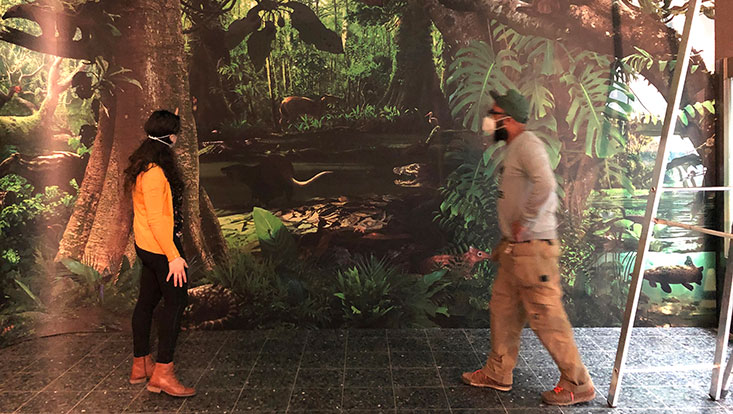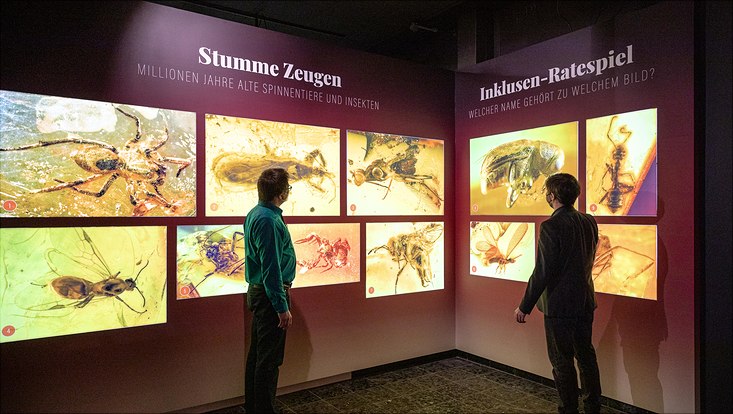
Exhibition design: Between facts and fantasy
26 March 2021

Photo: UHH/CeNak, Paran Pour
Exhibition designer Julia Pawlowski and carpenter Martin Reinhardt setting up the exhibition.
The Eocene is a bygone age that ended about 34 million years ago. How do you bring the nature of this time to life for an exhibition? How do you succeed in astonishing visitors with scientific findings, fossils and fragments? Julia Pawlowski is a designer specializing in visual science communication. Together with the scientific curators, she has given the Eocene exhibition its face.
An interview with exhibition designer Julia Pawlowski:
How do you bring a long-gone age of the earth to us in the present?
To achieve this, I first had to consciously break with the usual visual habits and expectations that are often associated with a paleontological exhibition. Although visitors can expect to see fossils in typical gray and brown tones, they are also immersed in an extremely colorful world of colors.
The exhibition is divided into three parts, not only thematically but also visually: Blue stands here for the cosmic catastrophe of the meteorite impact, without which the Eocene would not have existed at all. Green stands for the diverse jungle world that shaped the landscape in Eocene Germany in a way we can hardly imagine today. The evening red rounds off the exhibition, in which the large amber inclusions in their typical yellow are particularly accentuated, giving a new visual expression to the word "sunstones", as amber is also called.
In addition, the name "Eocene" means new beginning, but can also stand for "dawn" or "daybreak". Therefore, all three color worlds are connected by another visual component - a small light strip is attached to the hem of the information panels and exhibition furniture. The sun is thus always present as a glimmer, depending on which color world the visitors are currently moving through. Like the dawn of a new day.
To what extent does an exhibition help us to understand scientific contexts?
When scientists examine fossils and amber finds from the Eocene, their expertise means that they already have a lot of background knowledge about the individual objects, which they can directly visualize in their minds and put into a broader context. For example, they have ideas and knowledge about how a particular animal lived, what it looked like and what it might have eaten, or what its natural habitat was like.
When visitors look at a fossil skeleton in a museum, they often lack this comprehensive contextual knowledge and thus often miss out on the sensation and cumulative knowledge that can be hidden behind a single find.
As a communication designer, I have the task of making as much of this contextual knowledge as possible, and also all the questions that researchers have about a particular fossil, directly visible to visitors. In a way, I become the translator between the research and the public.
That's why the exhibition is very rich in images and colorful - in every corner hides an image of a creature from the Eocene, often in different styles and variations, ranging from photographs to painted illustrations to 3D animation. After all, even scientific work is often a mosaic-like piecemeal of theory development, investigation, and building on knowledge already gained. It is never completely finished and is composed of many fragments. The image-rich exhibition is thus a kind of visualization of the current state of research and the associated research questions - and allows visitors a new approach to it.
What is the arc of tension that leads the most diverse visitors through the exhibition?
Visitors can get to know the world of the Eocene from very different perspectives: While the Jungle Room, like a journey through time, is primarily about the former Messel Lake and the living environment in Eocene Germany, the Amber Room offers the opportunity to take on the perspective of science: How are amber inclusions studied? And what do researchers see when they look into a microscope? For each perspective, exhibits, texts and also visual focal points have been chosen accordingly. In the discovery line, children and their companions are also taken by the hand by our "Forscherchen", a little mascot, and playfully guided through the exhibition.
Julia Pawlowski is a designer specializing in visual science communication. She works as an exhibition designer, graphic artist and as a consultant for the visual presentation of research work. To the picture gallery "Experimental Field of Exhibition Design
More information about the special exhibition "Eocene - At the beginning of our world".

